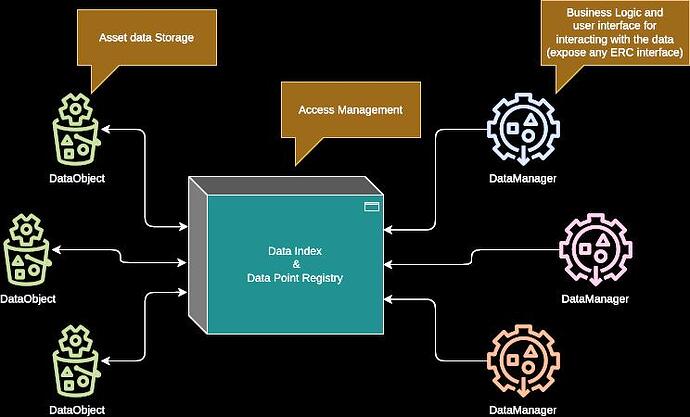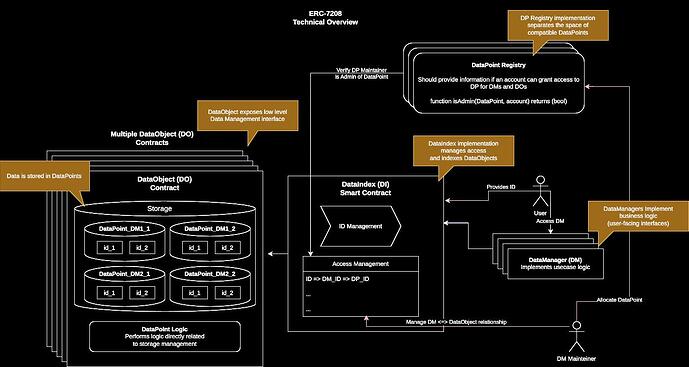UPDATE January 2025 -
The ERC-7208 is pushing to FINAL
The audit report is here
An example implementation can be found here, where an ERC-1155 and many ERC-20 share storage
Other implementations and tools will be posted here, thanks to the Nexera Network
Special thanks to Omniscia for their contributions.
/******************* About This ERC ********************************/
Hello Magicians,
Today we are excited to introduce ERC-7208, a set of interfaces that we call the On-Chain Adapters:
- DataIndex (DI) → indexes information and approvals of DataManagers to DataPoints through DataObjects
- DataManager (DM) → interfaces with user, implements business logic or “high-level” data management
- DataObject (DO) → logic implementing "low-level data storage management
- DataPoint (DP) → indexed low-level data pointer (bytes32)
- DataPoint Registry (DPR) → defines a space of data point compatibility/access management
Abstract
This ERC defines a series of interfaces for the abstraction of storage of on-chain data by implementing the logic functions that govern such data on independent smart contracts. “On-chain Data Containers” (ODCs) refer to the separation and indexing of data storage away from data management. We propose that on-chain data can be abstracted and stored in smart contracts called “Data Objects” (DO), which answer to external data indexing mechanisms named “Data Points” (DP). This data can be accessed and modified by implementing (one or many) separate smart contracts identified as “Data Managers” (DM). We introduce two mechanisms for access management: first, through a “Data Index” (DI) implementation, the “Data Managers” (DM) can be gated from accessing “Data Objects” (DO); second, a “Data Point Registry” (DPR) implementation manages the issuance of “Data Points” (DP). Lastly, we introduce the concept of data portability (horizontal data mobility) between implementations of “Data Index” (DI), enabling massive updates to the logic without affecting the underlying data storage.
Motivation
As the Ethereum ecosystem grows, so does the demand for on-chain functionalities. The market encourages a desire for broader adoption through more complex systems and there is a constant need for improved efficiency. We have seen times when an explosion of new standard token proposals was solely driven by market hype. While ultimately each standard serves its purpose, most of them require more flexibility to manage interoperability with other standards. A standard adapter mechanism is needed to enhance interoperability by driving the interactions between assets issued under different ERCs.
Without such mechanisms, most projects have implemented bespoke solutions for interoperability. This is an inefficient approach and leads to a fragmented ecosystem. We recognize there is no “one size fits all” solution to solve the standardization and interoperability challenges. Most assets - Fungible, Non-Fungible, Digital Twins, Real-world Assets, DePin, etc - have multiple mechanisms for representing them as on-chain tokens through the use of different standard interfaces and the diversity of standards spurs innovation.
However, for these assets to be exchanged, traded, or otherwise interacted with, protocols must implement compatibility with the relevant interfaces to access and modify on-chain data. This is especially challenging when considering the previously mentioned bespoke solutions for interoperability. Additionally, the immutability of smart contracts complicates the ability of already deployed protocols to adapt to new tokenization standards, which is critical for future-proofing implementations. A collaborative effort must be made to enable interaction between assets tokenized under different standards. The current ERC provides the tools for developing such on-chain adapters.
We aim to abstract the on-chain data handling from the logical implementation, exposing the underlying data independently of the ERC interface. We propose a series of interfaces for storing and accessing data on-chain in contracts called “Data Objects” (DO), grouping the underlying assets as generic “Data Points” (DP) that may be associated with multiple interoperable and even concurrent “Data Manager” (DM) contracts. This proposal is designed to work by coexisting with previous and future token standards, providing a flexible, efficient, and coherent mechanism to manage asset interoperability.
-
Data Abstraction: We propose a standardized interface for enabling developers to separate the data storage code from the underlying token utility logic, reducing the need for supporting and implementing multiple inherited -and often clashing- interfaces to achieve asset compatibility. The data (and therefore the assets) can be stored independently of the logic that governs such data.
-
Standard Neutrality: A neutral approach must enable the underlying data of any tokenized asset to transition seamlessly between different token standards. This will significantly improve interoperability among other standards, reducing fragmentation in the landscape. Our proposal aims to separate the storage of data representing an underlying asset from the standard interface used for representing the token.
-
Consistent Interface: A uniform interface of primitive functions abstracts the data storage from the use case, irrespective of the underlying token’s standard or the interface exposing such data. Data and metadata can be stored on-chain, and exposed through the same primitives.
-
Data Portability: We provide a mechanism for the Horizontal Mobility of data between implementations of this standard, incentivizing the implementation of interoperable solutions and standard adapters.
Terms
-
Data Point: A uniquely identifiable reference to an on-chain data structure stored within one or many Data Objects and managed by one or many Data Managers. Data Points are issued by a Data Point Registry.
-
Data Object: A Smart Contract implementing the low-level storage management of information indexed through Data Points.
-
Data Manager: One or many Smart Contracts implementing the high-level logic and end-user interfaces for managing Data Objects.
-
Data Point Registry: One or many Smart Contracts used for managing the issuance of Data Points. Additionally, a Data Point Registry defines a space of compatible or interoperable Data Points.
-
Data Index: One or many Smart Contracts used for managing the access of Data Managers to Data Objects.

